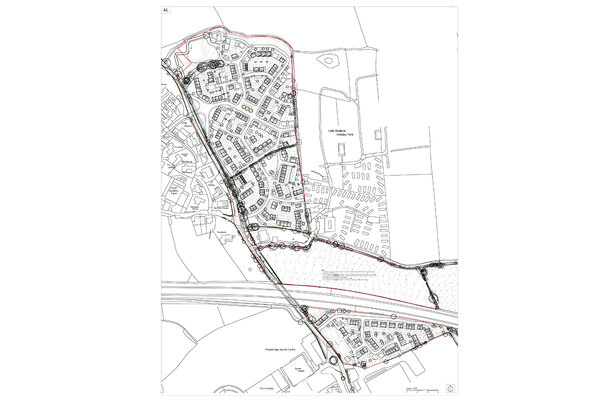You are viewing 1 of your 1 free articles
Sophie’s world: meet the woman investing Homes England’s £3bn fund
Sophie White is charged with investing Homes England’s £3bn Home Building Fund. Martin Hilditch finds out how she’s looking to disrupt the status quo. Photography by Peter Searle
If all goes according to plan, Sophie White will play a central role in the delivery of more than 100,000 homes over the next few years.
As head of infrastructure, private rented sector (PRS) and complex projects at Homes England she’s charged with making sure the agency’s £3bn Home Building Fund is well deployed.
Ms White is specifically focused on investing the £2bn chunk of the fund set aside to deliver infrastructure, such as new roads, that will help get potentially tricky housing developments off the ground. Success will mean the agency’s investment results in at least 160,000 new homes.
As her chunky job title suggests, she is also responsible for enabling the growth of the still relatively embryonic build-to-rent market in England.
Last year, she was involved in getting the first real estate investment trust (REIT) dedicated to the PRS off the ground, unlocking more than 2,500 homes.
In 2017, the agency made an initial investment of 9.99% – nearly £25m – in the tax-efficient investment vehicle, called The PRS REIT. Homes England invested a further £5m in the REIT last month.
With hundreds of millions of pounds of investment – and hundreds of thousands of people’s future homes – resting on the decisions made, it’s probably a good job Ms White says one of her chief qualities is being “naturally quite positive”.
Inside Housing met Ms White to find out a bit more about the person charged with investing such a large chunk of the agency’s most high-profile funds, and ask what progress she expects to make with it in 2018
Appropriately enough for someone who describes herself on Twitter as a “frustrated equestrian”, we meet for a coffee at The Loose Box bar and restaurant, close to Homes England’s offices (a loose box, for less equestrian readers, is a stable in which a horse is kept but doesn’t need to be tied up).
Ms White answers questions directly and thoughtfully, often breaking off in the middle of a sentence to provide more context.
“When I first joined the agency we were quite a passive lender....that is absolutely different now"
She’s clear from the outset that times are changing at Homes England, stating that its chief executive Nick Walkley – who joined the then Homes and Communities Agency (HCA) last year – wants to “change attitudes in terms of what we will do and what we will get involved in”.
“When I first joined the agency we were quite a passive lender I think,” she says, adding that “there might have been a perception historically that the money is put in and we wouldn’t say anything else”.
“That is absolutely different now,” she adds, stating that her role now is “engaging much more with the market about what they can do, what we can do, and how we improve markets”. Her role, along with other senior Homes England leaders, is to ask: “Why are we doing this? What are we actually delivering? Is it having a beneficial output?”
To date, Ms White – whose patch is Birmingham and the South of England – estimates she has been directly involved in roughly £750m of funding that has been granted since she joined the then HCA in 2013.
When it comes to the Home Building Fund, Ms White says about half of the £3bn is currently “either committed or contracted”. She adds: “We have a very strong pipeline. I don’t think there’s any concern we’re not going to be deploying the funds.”
At the moment, Ms White says, Homes England acts as an almost unique lender when it comes to infrastructure loans.
“It is not something the funding market is really providing, particularly over the terms of the loan. Eight to 10 years is a totally normal loan for us.” (Development finance loans are typically two to three years, but there isn’t really an equivalent product in the market, she says.) There are no maximum loan sizes, but the largest to date has been £200m.
Ms White says it would be “fabulous” if there were other lenders offering similar products in the market, because Homes England wants to change markets and only invest where it will make a real difference to delivery. “We are always trying to lead,” she states. “So there is always a desire to prove a product and prove that things are possible. I don’t think we would ever say ‘we are the only ones who are ever going to do this’, but there are challenges around [funding infrastructure] that will make it difficult for some.”
“There is always a desire to prove a product and prove things are possible.”
Throughout, Ms White says the agency’s approach is about “challenging people to think about what they are doing and how they are doing it and thinking about how we can do things better and more quickly”.
She adds: “We are a lender, but that becomes a relationship, so it is not just a case of ‘we will fund it and you can do what you would like to do’.”
This challenge has to be internal too, she feels. “We obviously have our own internal risk panels and approval panels and they occasionally might have their head in their hands thinking ‘what have they brought now?’,” she says with a laugh. “But actually it is part of being challenging. What we try to be is really dynamic. The fund is the fund. But how we utilise it – whether that be debt, senior debt, infrastructure debt, REITs, equity – we are increasingly having the opportunity to be very innovative with our own capital funds.”
The PRS REIT, which was launched by Sigma Capital, is a case in point.
“I think three or four months before the REIT came up, if someone had said to Homes England ‘are you going to be a capital investor in a REIT?’ probably it would have been ‘oh, we’re not sure about that’,” she says. “But actually Sigma comes and it says ‘we have a really good case for this’… they had an excellent seed portfolio [of properties]… ‘government, if you can just give us that supporting sticker then we think it will really make a difference’.”
After being “delighted” with the success of The PRS REIT (it has identified a pipeline of around 3,800 new homes and current investment accounts for around 1,720 homes in the North West, Midlands and South Yorkshire) Homes England would “absolutely” consider involvement in other REITs in the future. It’s a model Ms White sees developing because “there is a huge breadth of people who would benefit from having stable, investment-grade rental accommodation”. She adds: “What we should be thinking about is how it can be utilised as effectively as possible to meet what is still a huge problem in terms of housing numbers.”
What about the state of the broader PRS market? Homes England has been a huge player in the market through its Build to Rent Fund, which was launched to stimulate growth in the sector with £200m in 2012, with a further £800m announced in the 2013 Budget.
“We probably are still the biggest lender in the market,” Ms White says. But homes built under Built to Rent Fund rounds one and two now start to prove the model works, she adds.
Success for Homes England will come when it loses its position as the dominant lender – “we are not here to crowd people out”. Part of the role of Ms White and her team is to introduce borrowers who want to deliver PRS schemes to potential lenders and get involved directly only if needed.
“We probably are still the biggest lender in the market”
The agency is also interested in developing the model in different parts of the country where it may prove successful, she adds. While PRS markets in London and Manchester are already “very active”, she adds that “there are still some regional locations where that build-to-rent market is right at the beginning and that is where we try and direct our interest now”.
Leeds, Birmingham and Bristol are areas that are attracting the agency’s attention, she adds.
Ms White cites the example of the £44m backing in December 2016, in addition to senior lender HSBC, that the agency gave to a scheme by Dandara to deliver more than 2,000 new PRS homes across Manchester, Leeds and Birmingham.
“They had found a senior lender who could get to 60%, but 40% of £300m is an awful lot of money in anyone’s terms.” By stepping in “we were then able to just take that pressure off equity, which means they started all three schemes together [rather than risking delays to some]”.
“That for us is a huge response for a relatively limited amount of capital.”
Ms White describes Homes England’s mission as being “to be brave, to be bold, to really get involved”.
“I’m hoping in a year’s time we will look back and say we have done that,” she adds. In other words, if Homes England surprises you this year, then it’s job well done.












